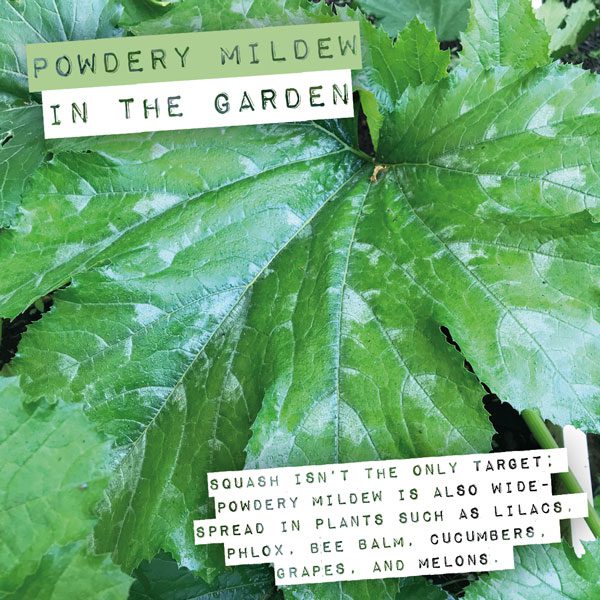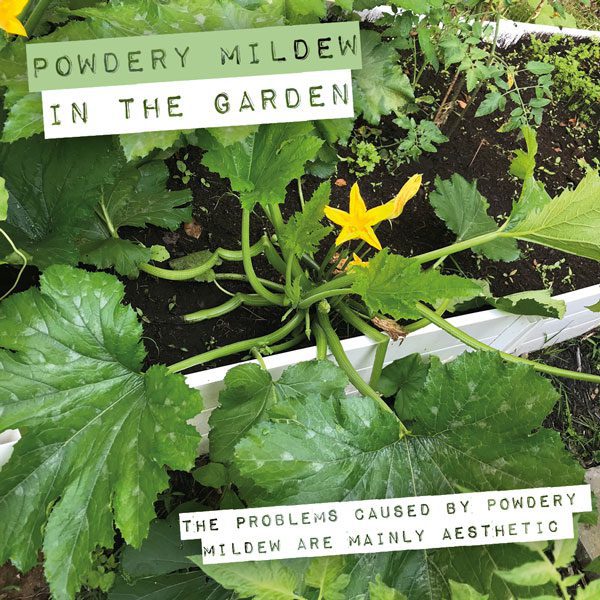I’m always amazed by how quickly zucchinis grow; they seem to appear overnight, sometimes. Unfortunately, so does powdery mildew.
During a recent stretch of hot and humid weather, I noticed my zucchini plants weren’t looking so perfect anymore. Their big leaves had white spots all over them.
The panic set in; was this the end of my zucchini crop? Is it contagious to my other precious plants? Was the party over before it ever truly began?
Calm The Hell Down!
After some research in my gardening bible, Gardening Complete: How To Best Grow Vegetables, Flowers, and Other Outdoor Plants, I’m relieved to know that the problems caused by this disease are mainly aesthetic.
In other words, while my zucchini plant may not look as green as it once did, it should continue to produce squash regularly. Phew!
There are still a few steps gardeners should be taking to fight the infection. If it becomes too severe, it could affect yields and other parts of the garden.
What Is Powdery Mildew?

Squash isn’t the only target; powdery mildew is also widespread in plants such as lilacs, phlox, bee balm, cucumbers, grapes, and melons.
The infection is caused by several species of fungal organisms, which live on the leaf surface.
Fungi produce spores, which, depending on the species, can spread quickly through the air, water, and other objects, such as garden tools.
The Causes
Fungal spores need moisture to thrive, so gardeners will typically notice an infestation on their crops during periods of high humidity or when it’s been wet.
Prevention
An easy way to fight off powdery mildew is to keep the foliage of your plants as dry as possible. That means always watering from the base of the plant, rather than spraying the garden wildly with a hose.
 Good air circulation is also essential, so space your plants appropriately in the garden. Each crop needs enough room to grow, and by giving it some space, the stems and leaves will dry faster after it rains.
Good air circulation is also essential, so space your plants appropriately in the garden. Each crop needs enough room to grow, and by giving it some space, the stems and leaves will dry faster after it rains.
Proper spacing will also better prevent powdery mildew from jumping to a neighboring plant.
Finally, choose disease-resistant varieties for the garden. Many plants have antimicrobial chemicals, proteins, and enzymes within them that naturally help fight off disease. Most seed catalogs and packets will tell you how resistant a specific crop is to various pathogens.
Control
Since powdery mildew is mostly an aesthetic issue, there’s no need to go to the extreme to control it.
Still, I do like a beautiful, healthy-looking green leaf, something many gardeners can appreciate.
Organic fungicides can easily do the trick, and so will a dose of neem oil or bicarbonates, which kill any fungus they come into contact with.
The Solution
I chose to take the easy, affordable, and all-natural route by mixing three cups of water with one teaspoon of baking soda in a spray bottle.
I have started spraying the solution onto the leaves of my plant every morning before the sun gets too hot. I’m also applying it to the leaves of the neighboring crops to keep them from developing any white spots.

Disposal
An important note: when removing foliage and plants with powdery mildew from the garden at the end of the growing season, do not add them to your backyard compost pile. You’ll risk reintroducing the disease to the garden next season!
Be sure to send any infected plant material off to the municipal compost center.
Thank you for your help I really do appreciate it.
🙂